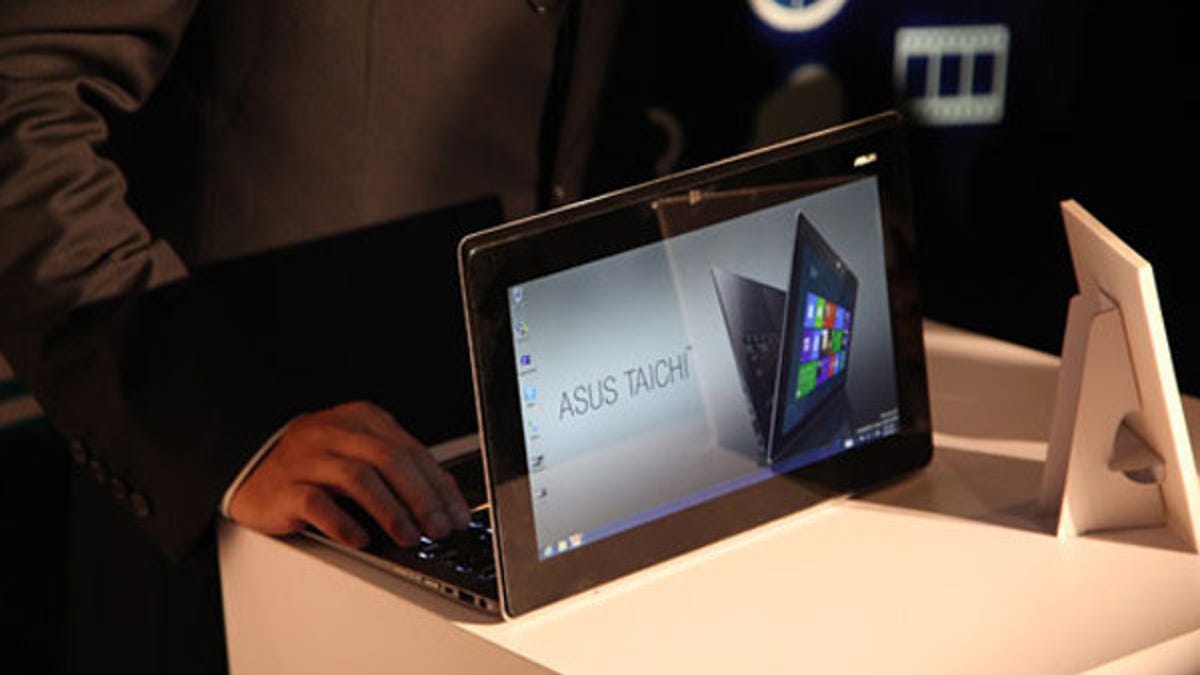Dual-screen Taichi leads lineup of unique Asus Windows 8 PCs
Asus takes advantage of Microsoft's flexible new OS with a dual-screen laptop, laptops and tablets with removable keyboards, and even a desktop with a removable screen.

TAIPEI, Taiwan--Windows 8, we've been told, is going to move Microsoft into the post-PC era. And a bevy of new PC designs that Asus debuted here at the Computex trade show is bringing that vision to reality.
The Taiwanese PC manufacturer has take the wraps off three new product lines -- a dual-screen ultrabook, a semiportable all-in-one desktop, and a convertible laptop with a removable keyboard -- that build on the lessons of the company's Transformer line of Android tablets.
Taichi: Tablet, ultrabook, or both?
First up from Asus was the Taichi hybrid notebook/tablet, which was hinted at by the company in a teaser video last week. This device (shown above) is in a notebook form factor and comes with full-HD screens on both sides of the lid. The one on the outside is touch-capable and also supports a stylus.
Asus told us that the two screens work independently and that both can be used for different applications at the same time. This opens up possibilities such as having someone play a Metro-style app while another person types away at the keyboard end. Obviously, Windows 8 is required for this to work.
The Taichi will come with both 11.6- and 13.3-inch screen sizes and Asus claims that it will be as light as its
Transformer laptops and tablets
For those who prefer a full-fledged notebook experience, the Asus Transformer Book is the company's answer. It's a convertible notebook, with a detachable screen that has multitouch support.
More importantly, it is powered by an Ivy Bridge Core i7 processor, though it will have Core i3 and i5 options when it's available. Discrete graphics is another option (Asus told us it hasn't decided on whether it will use AMD or Nvidia graphics). The Book will also have SSD or HDD storage along with 4GB of RAM and USB 3.0 ports.
Asus also launched a number of Transformer-like tablets with keyboard docks. They also support Asus SonicMaster audio and have NFC sensors onboard. The difference between these two tablets lies in the version of Windows 8 installed. The Asus Tablet 810 runs on the x86 version of Windows 8 whereas the Tablet 600 uses the ARM-compatible Windows RT.
The 11.6-inch 810 uses an Intel Atom processor (Clover Trail-class) with 2GB of RAM and 64GB of internal storage. The screen resolution has a 1,366x768-pixel resolution and the display is said to use Super IPS+ technology, making it more readable outdoors. It also supports a Wacom digitizer stylus.
The smaller, 10.1-inch Tablet 600 features a quad-core Nvidia Tegra 3 chip with 2GB of RAM. There's only 32GB of storage, but the screen resolution and technology is identical to the 810.
While they come with keyboard docks, these won't work with current Asus Transformer products, though they still add USB ports and extend the battery life.
Transformer desktop and other news
A new Asus device that may leave consumers scratching their heads slightly is the Transformer AIO (all-in-one). Most of this is because of its large 18.4-inch multitouch display that can be removed from the dock, becoming a "wireless display for the AIO PC." This implies that the chunky dock for this device contains the PC innards used to power it. The interesting thing is that it runs dual operating systems, with just a single button to affect the transition.
Asus also launched a couple of monitors, the Designo MX279H and the MX239H. Both feature sharp, matte IPS panels with a sleek design and up to 178-degree viewing angles. Audio is also integrated and predictably, uses Asus' SonicMaster technology. We also saw a new Asus router, the RT-AC66U, which supports 802.11ac Wi-Fi standards and claims to offer Wi-Fi speeds of up to 1.75Gbps.
Beyond the unique hardware offerings, Asus also announced the Asus Open Cloud Computing, or AOCC for short. It was described as a "total solution for the ubiquitous cloud computing era." From what little we could tell during the presentation, it looks like the company is trying to integrate some of its existing cloud solutions, such as Asus WebStorage, into a more cohesive product.
The company has yet to reveal the price and availability on any of the hardware products. However, given the Windows 8 focus, we expect most of them will roll out with Microsoft's new OS toward the end of the year.
Editors' note: This is a slightly edited version of an earlier story that appeared on our sister site CNET Asia.